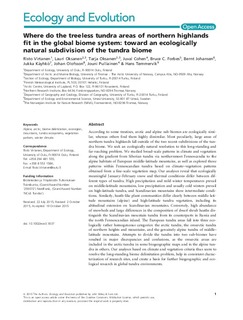| dc.description.abstract | According to some treatises, arctic and alpine sub-biomes are ecologically similar,
whereas others find them highly dissimilar. Most peculiarly, large areas of
northern tundra highlands fall outside of the two recent subdivisions of the tundra
biome. We seek an ecologically natural resolution to this long-standing and
far-reaching problem. We studied broad-scale patterns in climate and vegetation
along the gradient from Siberian tundra via northernmost Fennoscandia to the
alpine habitats of European middle-latitude mountains, as well as explored those
patterns within Fennoscandian tundra based on climate–vegetation patterns
obtained from a fine-scale vegetation map. Our analyses reveal that ecologically
meaningful January–February snow and thermal conditions differ between different
types of tundra. High precipitation and mild winter temperatures prevail
on middle-latitude mountains, low precipitation and usually cold winters prevail
on high-latitude tundra, and Scandinavian mountains show intermediate conditions.
Similarly, heath-like plant communities differ clearly between middle latitude
mountains (alpine) and high-latitude tundra vegetation, including its
altitudinal extension on Scandinavian mountains. Conversely, high abundance
of snowbeds and large differences in the composition of dwarf shrub heaths distinguish
the Scandinavian mountain tundra from its counterparts in Russia and
the north Fennoscandian inland. The European tundra areas fall into three ecologically
rather homogeneous categories: the arctic tundra, the oroarctic tundra
of northern heights and mountains, and the genuinely alpine tundra of middlelatitude
mountains. Attempts to divide the tundra into two sub-biomes have
resulted in major discrepancies and confusions, as the oroarctic areas are
included in the arctic tundra in some biogeographic maps and in the alpine tundra
in others. Our analyses based on climate and vegetation criteria thus seem to
resolve the long-standing biome delimitation problem, help in consistent characterization
of research sites, and create a basis for further biogeographic and ecological
research in global tundra environments. | nb_NO |

